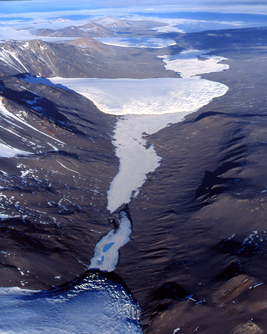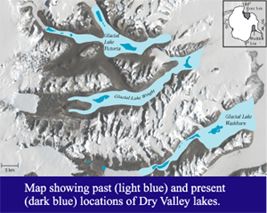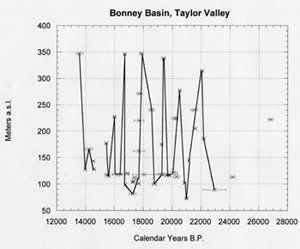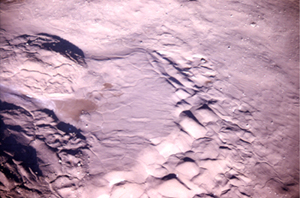Lakes in the Dry Valleys of Antarctica have
fluctuated dramatically over the past 30,000 years


Our work from the Dry Valleys of Antarctica indicates order-of-magnitude variations in the area and volume of closed-basin lakes on a millennial timescale. Major changes in water level point to climate and hydrologic conditions vastly different from those of today. The paleoclimate record derived from these water-level fluctuations will be used to test hypothesis of the global synchrony of climate change, and, ultimately, the cause of ice ages.
Main Discoveries:
(1) During the height of the last glaciation, the Dry Valleys were filled with lakes that were up to forty times larger than those that exist today.
(2) These lakes fluctuated hundreds of meters on a millennial timescale.
(3) A significantly different climate and hydrologic regime existed in the Dry Valleys during the times of global cooling. The cause for this is still under examination, but many relate to alteration in the location of storm tracks in the Ross Sea region.
Lake-level changes are derived from radiocarbon-dated ancient deltas and shorelines that are perched on the valley walls, well above the levels of the present-day lakes. Over two hundred and fifty dates from such features constrain lake-level curves for four basins
Our work on lakes also has contributed to the discovery (with Dr. C. Hendy) of the lake-ice conveyor - a mechanism by which glacial debris can be transported on the surface of a perennially ice-covered proglacial lake far beyond the glacier grounding line. This discovery has led to the reinterpretation of the surficial geology of the easter Dry Valleys.


This research was sponsored by the Office of Polar Programs of the National Science Foundation.
Selected References
Hall, B.L., Denton, G.H., Overturf, B., and Hendy, C.H., 2002. Glacial Lake Victoria, a high-level Antarctic lake inferred from lacustrine deposits in Victoria Valley: Journal of Quaternary Science, v.17, in press.
Hall, B.L., Denton, G.H., and Overturf, B., 2001. Glacial Lake Wright, a high-level Antarctic lake during the LGM and early Holocene: Antarctic Science, V.13, p. 53-60.
Hall, B.L., and Henderson, G.M., 2001. Use of TIMS uranium-thorium dating to determine past reservoir effects in lakes: Examples from Antarctica: Earth and Planetary Science Letters, v. 193, p. 565-577.
Hall, B.L., Denton, G.H., and Handy, C.H., 2000. Evidence from Taylor Valley for a grounded ice sheet in the Ross Sea, Antarctica: Geografiska Annaler, v. 82A, 275-303.
Hall, B.L., and Denton, G.H., 2000. Radiocarbon chronology of Ross Sea drift, eastern Taylor Valley, Antarctica: Evidence for a grounded ice sheet in the Ross Sea at the last glacial maximum: Geografiska Annaler, v. 82A, p. 305-336.
Hall, B.L., and Denton, G.H., 1998. Millennial-scale oscillations of closed-basin Antarctic lakes: Mechanisms of Millennial-Scale Climate Change, AGU Chapman Conference: Snowbird, Utah.
Hendy, C.H., Sadler, A.J., Denton, G.H., and Hall, B.L., 2000. Proglacial lake-ice conveyors: A new mechanism for deposition of drift in polar environments: Geografiska Annaler, v. 82A, p.249-270.

